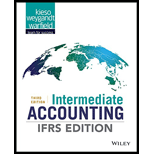
Intermediate Accounting: IFRS Edition
3rd Edition
ISBN: 9781119372936
Author: Donald E. Kieso, Jerry J. Weygandt, Terry D. Warfield
Publisher: WILEY
expand_more
expand_more
format_list_bulleted
Question
Chapter 13, Problem 1CA
To determine
Liability: Liability can be defined as the amount payable by the company to stakeholders.
(a)
To determine the essential characteristics that makes an item a liability.
To determine
(b)
To distinguish: To distinguish between a current liability and a long-term liability.
To determine
(c)
To determine the meaning of accrued liabilities with examples.
To determine
(d)
To determine the correct way to value liabilities and how current liabilities is usually valued.
To determine
(e)
To determine why notes payable are reported first in the current liabilities section.
To determine
(f)
To determine what might be the items that comprise M’s liability for “Compensation to employees”.
Expert Solution & Answer
Want to see the full answer?
Check out a sample textbook solution
Students have asked these similar questions
??
Please provide correct solution and financial accounting question
TimberTech, Inc. manufactures power drills that sell for $85. Each power drill uses $18 in direct materials and $12 in direct labor per unit. TimberTech has two activities: Assembly, which is applied at the rate of $6 per machine hour, and Packaging, which is applied at the rate of $30 per batch. This month, TimberTech made 400 power drills, using 1,200 machine hours in 50 batches. What is the total manufacturing cost for one power drill?
Chapter 13 Solutions
Intermediate Accounting: IFRS Edition
Ch. 13 - Prob. 1QCh. 13 - Prob. 2QCh. 13 - 3. Why is the liabilities section of the balance...Ch. 13 - Prob. 4QCh. 13 - Prob. 5QCh. 13 - Prob. 6QCh. 13 - Prob. 7QCh. 13 - Prob. 8QCh. 13 - Prob. 9QCh. 13 - Prob. 10Q
Ch. 13 - Prob. 11QCh. 13 - Prob. 12QCh. 13 - Prob. 13QCh. 13 - Prob. 14QCh. 13 - Prob. 15QCh. 13 - Prob. 16QCh. 13 - Prob. 17QCh. 13 - Prob. 18QCh. 13 - Prob. 19QCh. 13 - Prob. 20QCh. 13 - Prob. 21QCh. 13 - Prob. 22QCh. 13 - Prob. 23QCh. 13 - Prob. 24QCh. 13 - Prob. 25QCh. 13 - Prob. 26QCh. 13 - Prob. 27QCh. 13 - Prob. 28QCh. 13 - Prob. 29QCh. 13 - Prob. 30QCh. 13 - Prob. 31QCh. 13 - Prob. 1BECh. 13 - Prob. 2BECh. 13 - Prob. 3BECh. 13 - Prob. 4BECh. 13 - Prob. 5BECh. 13 - Prob. 6BECh. 13 - Prob. 7BECh. 13 - Prob. 8BECh. 13 - Prob. 9BECh. 13 - Prob. 10BECh. 13 - Prob. 11BECh. 13 - Prob. 12BECh. 13 - Prob. 13BECh. 13 - Prob. 14BECh. 13 - Prob. 15BECh. 13 - E13-1 (L01) (Balance Sheet Classification of...Ch. 13 - Prob. 2ECh. 13 - Prob. 3ECh. 13 - Prob. 4ECh. 13 - Prob. 5ECh. 13 - Prob. 6ECh. 13 - Prob. 7ECh. 13 - Prob. 8ECh. 13 - E13-9 (LO2) (Refinancing of Short-Term Debt) On...Ch. 13 - Prob. 10ECh. 13 - Prob. 11ECh. 13 - E13-12 (L03) (Premium Entries) No Doubt Company...Ch. 13 - E13-13 (L03) (Contingencies) Presented below are...Ch. 13 - Prob. 14ECh. 13 - Prob. 15ECh. 13 - E13-16 (L04) (Financial Statement Impact of...Ch. 13 - Prob. 17ECh. 13 - Prob. 18ECh. 13 - Prob. 19ECh. 13 - Prob. 1PCh. 13 - P13-2 (L01,3) (Liability Entries and Adjustments)...Ch. 13 - Prob. 3PCh. 13 - Prob. 4PCh. 13 - Prob. 5PCh. 13 - Prob. 6PCh. 13 - Prob. 7PCh. 13 - Prob. 8PCh. 13 - Prob. 9PCh. 13 - Prob. 10PCh. 13 - Prob. 11PCh. 13 - Prob. 12PCh. 13 - Prob. 13PCh. 13 - Prob. 14PCh. 13 - Prob. 1CACh. 13 - Prob. 2CACh. 13 - Prob. 3CACh. 13 - Prob. 4CACh. 13 - Prob. 5CACh. 13 - Prob. 6CACh. 13 - Prob. 7CACh. 13 - Prob. 1UJCh. 13 - Prob. 2UJCh. 13 - Prob. 3UJCh. 13 - Prob. 4UJCh. 13 - Prob. 1CECh. 13 - Prob. 2CECh. 13 - Prob. 3CECh. 13 - Prob. 4CECh. 13 - Prob. 1CRCCh. 13 - Prob. 1ISTCh. 13 - 2. In accounting for short-term debt expected to...Ch. 13 - Prob. 3ISTCh. 13 - Prob. 4ISTCh. 13 - Prob. 5ISTCh. 13 - Prob. 1ICACh. 13 - Prob. 2ICACh. 13 - Prob. 3ICACh. 13 - Prob. 4ICACh. 13 - Prob. 5ICACh. 13 - Prob. 6ICACh. 13 - Prob. 7ICACh. 13 - Prob. 8ICACh. 13 - Prob. 9ICACh. 13 - Prob. 10ICACh. 13 - Prob. 11ICACh. 13 - Prob. 12ICA
Knowledge Booster
Similar questions
- I am looking for the correct answer to this financial accounting problem using valid accounting standards.arrow_forwardPlease explain the correct approach for solving this general accounting question.arrow_forwardI need help finding the accurate solution to this financial accounting problem with valid methods.arrow_forward
arrow_back_ios
SEE MORE QUESTIONS
arrow_forward_ios
Recommended textbooks for you

 AccountingAccountingISBN:9781337272094Author:WARREN, Carl S., Reeve, James M., Duchac, Jonathan E.Publisher:Cengage Learning,
AccountingAccountingISBN:9781337272094Author:WARREN, Carl S., Reeve, James M., Duchac, Jonathan E.Publisher:Cengage Learning, Accounting Information SystemsAccountingISBN:9781337619202Author:Hall, James A.Publisher:Cengage Learning,
Accounting Information SystemsAccountingISBN:9781337619202Author:Hall, James A.Publisher:Cengage Learning, Horngren's Cost Accounting: A Managerial Emphasis...AccountingISBN:9780134475585Author:Srikant M. Datar, Madhav V. RajanPublisher:PEARSON
Horngren's Cost Accounting: A Managerial Emphasis...AccountingISBN:9780134475585Author:Srikant M. Datar, Madhav V. RajanPublisher:PEARSON Intermediate AccountingAccountingISBN:9781259722660Author:J. David Spiceland, Mark W. Nelson, Wayne M ThomasPublisher:McGraw-Hill Education
Intermediate AccountingAccountingISBN:9781259722660Author:J. David Spiceland, Mark W. Nelson, Wayne M ThomasPublisher:McGraw-Hill Education Financial and Managerial AccountingAccountingISBN:9781259726705Author:John J Wild, Ken W. Shaw, Barbara Chiappetta Fundamental Accounting PrinciplesPublisher:McGraw-Hill Education
Financial and Managerial AccountingAccountingISBN:9781259726705Author:John J Wild, Ken W. Shaw, Barbara Chiappetta Fundamental Accounting PrinciplesPublisher:McGraw-Hill Education


Accounting
Accounting
ISBN:9781337272094
Author:WARREN, Carl S., Reeve, James M., Duchac, Jonathan E.
Publisher:Cengage Learning,

Accounting Information Systems
Accounting
ISBN:9781337619202
Author:Hall, James A.
Publisher:Cengage Learning,

Horngren's Cost Accounting: A Managerial Emphasis...
Accounting
ISBN:9780134475585
Author:Srikant M. Datar, Madhav V. Rajan
Publisher:PEARSON

Intermediate Accounting
Accounting
ISBN:9781259722660
Author:J. David Spiceland, Mark W. Nelson, Wayne M Thomas
Publisher:McGraw-Hill Education

Financial and Managerial Accounting
Accounting
ISBN:9781259726705
Author:John J Wild, Ken W. Shaw, Barbara Chiappetta Fundamental Accounting Principles
Publisher:McGraw-Hill Education